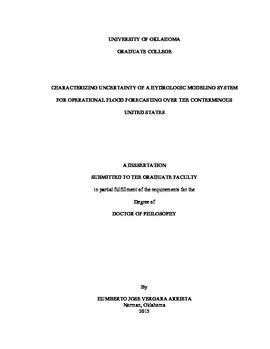| dc.contributor.advisor | Hong, Yang | |
| dc.contributor.author | Vergara, Humberto | |
| dc.date.accessioned | 2015-08-14T21:37:12Z | |
| dc.date.available | 2015-08-14T21:37:12Z | |
| dc.date.issued | 2015 | |
| dc.identifier.uri | https://hdl.handle.net/11244/15505 | |
| dc.description.abstract | The purpose of this work was to study the macro scale patterns of simulated streamflow errors in order to characterize uncertainty in a hydrologic modeling system and establish the basis for a probabilistic forecasting framework. The particular application of this endeavor is on flood and flash flood forecasting in an operational context. The hydrologic modeling system has been implemented at 1-km/5-min resolution to generate estimates of streamflow over the Conterminous United States (CONUS). The parameterization of the hydrologic model was prepared using spatially distributed information on soil characteristics, land cover/land use, and topography alone. An innovative method to estimate parameter values for the physics-based flow routing model was developed for the purpose of this research. Unlike the standard practice in hydrologic modeling exercises, no calibration of the hydrologic model was performed following its initial configuration. This calibration-free approach guarantees the spatiotemporal consistency of uncertainty and model biases, which is key for the methodology explored herein.
Data from the CONUS-wide stream gauge network of the United States’ Geological Survey (USGS) were used as a reference to evaluate the discrepancies with the hydrological model predictions. Only stream gauges with drainages less than or equal to 1,000 km2 were employed. Streamflow errors were studied at the event scale with particular focus on the peak flow magnitude and timing. A total of 2,680 catchments and 75,496 events were used for the error analysis. A methodology based on automatic processing algorithms was developed to deal with this large sample for model diagnostics.
Associations between streamflow errors and geophysical factors were explored and modeled. It was found that hydro-climatic factors and radar coverage could explain significant underestimation of peak flow in regions of complex terrain. Furthermore, the statistical modeling of peak flow errors showed that other geophysical factors such as basin geomorphometry and pedology could also provide explanatory information. Results from this research demonstrate the potential of uncertainty characterization in providing feedback for model improvement and its utility in enabling probabilistic flood forecasting that can be extended to ungauged locations. | en_US |
| dc.language | en | en_US |
| dc.subject | Hydrology | en_US |
| dc.subject | Water Resources | en_US |
| dc.subject | Flood Forecasting | en_US |
| dc.subject | Uncertainty Modeling | en_US |
| dc.title | CHARACTERIZING UNCERTAINTY OF A HYDROLOGIC MODELING SYSTEM FOR OPERATIONAL FLOOD FORECASTING OVER THE CONTERMINOUS UNITED STATES | en_US |
| dc.contributor.committeeMember | Gourley, Jonathan | |
| dc.contributor.committeeMember | Kolar, Randall | |
| dc.contributor.committeeMember | Knox, Robert | |
| dc.contributor.committeeMember | Wang, Xuguang | |
| dc.date.manuscript | 2015-08 | |
| dc.thesis.degree | Ph.D. | en_US |
| ou.group | College of Engineering::School of Civil Engineering and Environmental Science | en_US |
